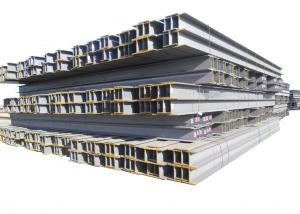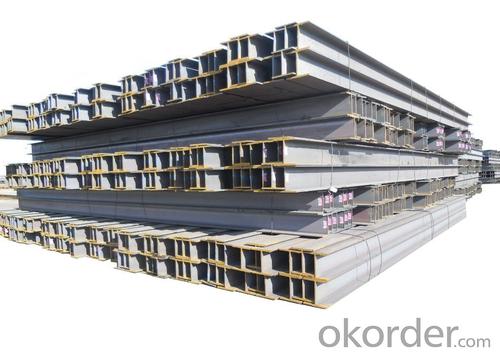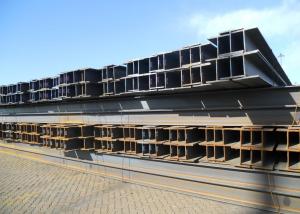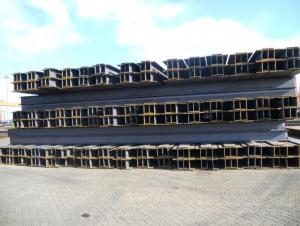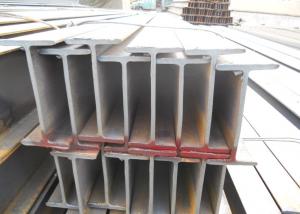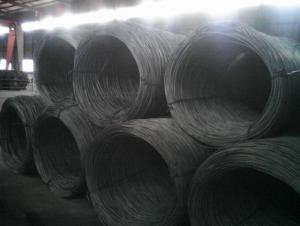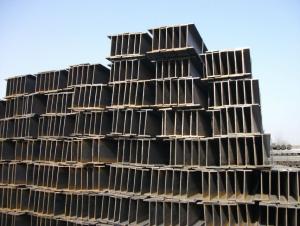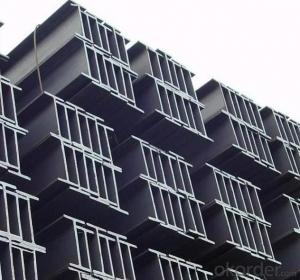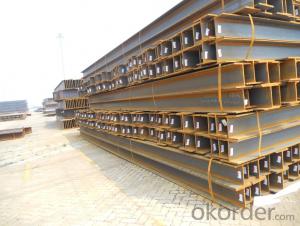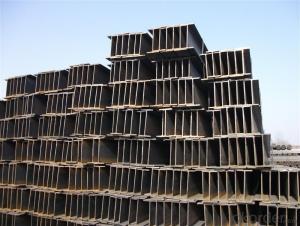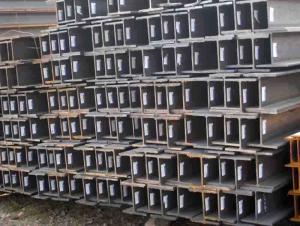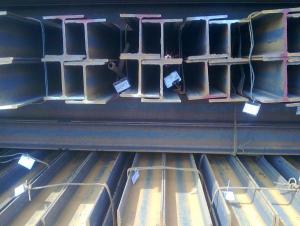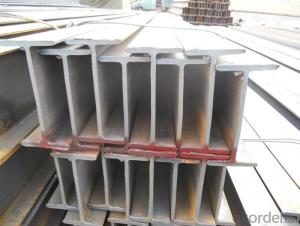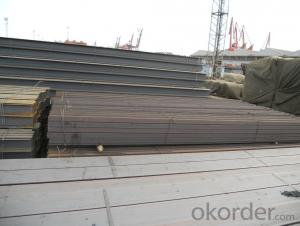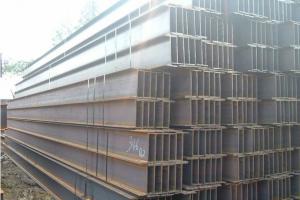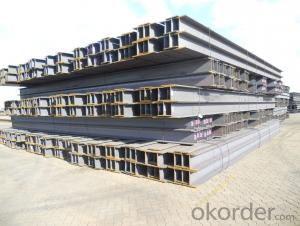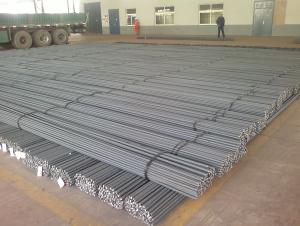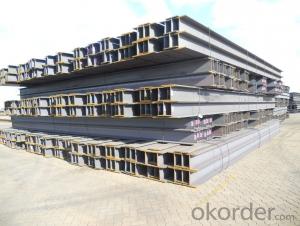Hot Rolled H-Beam Steel for Building Structures
- Loading Port:
- China Main Port
- Payment Terms:
- TT or LC
- Min Order Qty:
- 100MT m.t.
- Supply Capability:
- 10000MT m.t./month
OKorder Service Pledge
OKorder Financial Service
You Might Also Like
Specifications of Hot Rolled H-Beam Steel for Building Structures
1. Standard: JIS G3101, SS400(1987),GB700-88, Q235B,EN10034-1993 / EN10025-2004,
HEA100-HEA500,HEB100-HEB500
2. Grade: Q235, SS400 or Equivalent
3. Length: 6m,10m, 12m as following table
4. Invoicing on theoretical weight or actual weight as customer request
5.Payment: TT or L/C
6. Sizes:
SIZE(mm) | DIMENSION (kg/m) |
100*100 | 16.9 |
125*125 | 23.6 |
150*75 | 14 |
150*150 | 31.1 |
148*100 | 20.7 |
198*99 | 17.8 |
200*100 | 20.9 |
248*124 | 25.1 |
250*125 | 29 |
300*150 | 36.7 |
298*149 | 32 |
200*200 | 49.9 |
294*200 | 55.8 |
346*174 | 41.2 |
350*175 | 49.4 |
244*175 | 43.6 |
175*175 | 40.4 |
294*200 | 55.8 |
298*201 | 64.4 |
346*174 | 41.2 |
350*175 | 49.4 |
400*200 | 65.4 |
396*199 | 56.1 |
450*200 | 74.9 |
446*199 | 65.1 |
340*250 | 78.1 |
500*200 | 88.1 |
300*150 | 36.7 |
Usage & Applications of Hot Rolled H-Beam Steel for Building Structures
Commercial building structure ;Pre-engineered buildings; Machinery support structure; Prefabricated structure; Medium scale bridges; Ship-building structure. etc.
Packaging & Delivery of Hot Rolled H-Beam Steel for Building Structures
1. Packing: it is nude packed in bundles by steel wire rod
2. Bundle weight: not more than 3.5MT for bulk vessel; less than 3 MT for container load
3. Marks:
Color marking: There will be color marking on both end of the bundle for the cargo delivered by bulk vessel. That makes it easily to distinguish at the destination port.
Tag mark: there will be tag mark tied up on the bundles. The information usually including supplier logo and name, product name, made in China, shipping marks and other information request by the customer.
If loading by container the marking is not needed, but we will prepare it as customer request.
4. Transportation: the goods are delivered by truck from mill to loading port, the maximum quantity can be loaded is around 40MTs by each truck. If the order quantity cannot reach the full truck loaded, the transportation cost per ton will be little higher than full load.
5. Delivered by container or bulk vessel
Production flow of Hot Rolled H-Beam Steel for Building Structures
Material prepare (billet) —heat up—rough rolling—precision rolling—cooling—packing—storage and transportation
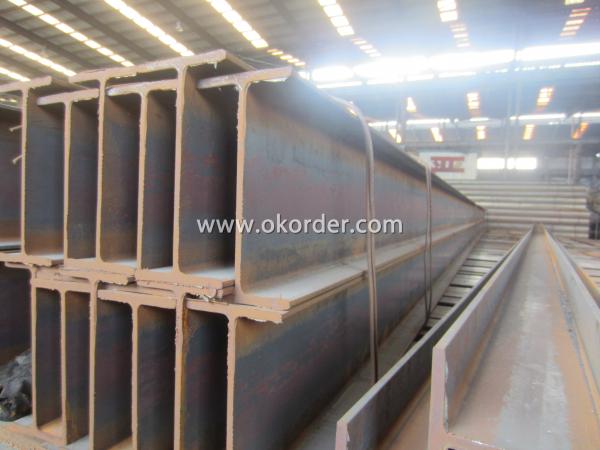
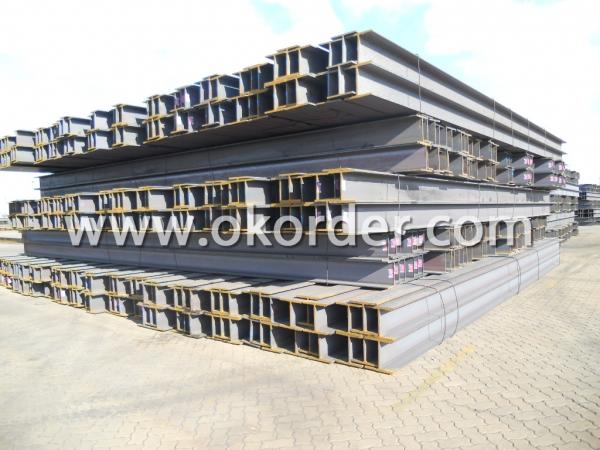
- Q: What are the fire resistance ratings for steel H-beams?
- The fire resistance ratings for steel H-beams depend on various factors such as the dimensions of the beam, the type of fire protection applied, and the specific building codes and regulations in place. Generally, steel H-beams have inherent fire-resistant properties due to their high melting point and structural stability. However, to enhance their fire resistance, additional fireproofing materials such as intumescent coatings or fire-resistant insulations can be applied. These measures can significantly increase the fire resistance ratings of steel H-beams, allowing them to withstand fire exposure for extended periods, typically ranging from 30 minutes to several hours.
- Q: Can steel H-beams be used in mezzanine or elevated flooring systems?
- Mezzanine or elevated flooring systems can indeed utilize steel H-beams. In construction, these beams are frequently employed because of their exceptional strength and capacity to bear heavy loads. They offer structural support and stability, rendering them ideal for the creation of elevated flooring systems like mezzanines. The distinctive H shape of the beam aids in the even distribution of weight, enabling larger spans and increased floor space. Furthermore, the seamless connection and integration of steel H-beams into the overall structure make them a favored option for mezzanine and elevated flooring systems.
- Q: Can steel H-beams be used in curved or sloped structures?
- No, steel H-beams are not typically used in curved or sloped structures as they are designed for straight and rigid construction. Curved or sloped structures usually require specialized curved beams or other structural elements that can accommodate the desired shape.
- Q: Can Steel H-Beams be used in sports or recreational facilities?
- Yes, Steel H-Beams can be used in sports or recreational facilities. Steel H-Beams are commonly used in the construction industry for their structural strength and durability. They provide excellent support for large spans and heavy loads, making them suitable for sports venues such as stadiums, arenas, and indoor sports facilities. Additionally, their versatility allows for creative and efficient designs in recreational facilities like gyms, fitness centers, and swimming pools.
- Q: Can steel H-beams be used for pedestrian bridges?
- Steel H-beams are indeed suitable for pedestrian bridges. Due to their structural strength and stability, they are commonly utilized in construction projects. These beams are engineered to withstand heavy loads and offer exceptional support, making them a perfect fit for bridges. Even though pedestrian bridges typically bear lighter loads compared to those for vehicles, they still necessitate a sturdy and long-lasting structure to ensure safety. By using steel H-beams, a robust framework can be established for pedestrian bridges, providing a secure and stable pathway for pedestrians. Furthermore, steel exhibits high resistance to environmental factors like corrosion, which is particularly crucial for bridges exposed to outdoor elements. Hence, steel H-beams present a fitting choice for the construction of pedestrian bridges.
- Q: Can steel H-beams be used in the construction of residential complexes or apartments?
- Yes, steel H-beams can be used in the construction of residential complexes or apartments. Steel H-beams are strong and versatile structural components that are commonly used in construction projects. They offer several advantages over other materials such as wood or concrete. Firstly, steel H-beams have a high strength-to-weight ratio, which means they can support heavy loads while being relatively lightweight themselves. This makes them ideal for constructing large or multi-story buildings like residential complexes or apartments. Secondly, steel H-beams provide excellent durability and resistance to various environmental factors such as earthquakes, hurricanes, and termites. They have high tensile strength, which means they can withstand significant forces and deformations without breaking. Moreover, steel H-beams are highly customizable and can be fabricated to meet specific design requirements. They can be easily cut, welded, and bolted together, allowing for flexible construction designs. Additionally, steel is a sustainable and eco-friendly material. It can be recycled indefinitely without losing its inherent properties, making it an environmentally responsible choice for construction projects. In summary, steel H-beams offer numerous advantages that make them suitable for the construction of residential complexes and apartments. Their strength, durability, versatility, and sustainability make them a popular choice among architects and builders in the construction industry.
- Q: Can steel H-beams be used for bridge construction?
- Yes, steel H-beams can be used for bridge construction. Steel H-beams, also known as I-beams or W-beams, are commonly used in bridge construction due to their strength and load-bearing capabilities. H-beams provide excellent structural support and can withstand heavy loads, making them suitable for bridges that need to support vehicular and pedestrian traffic. Additionally, steel H-beams are durable, resistant to corrosion, and can be easily fabricated and installed, making them a popular choice in bridge construction projects.
- Q: Do steel H-beams require any special maintenance?
- Steel H-beams typically do not require any special maintenance. However, regular inspections and preventive measures can help extend their lifespan and ensure their structural integrity. Some recommended maintenance practices for steel H-beams include: 1. Regular Inspection: Periodic inspections are important to identify any signs of corrosion, deformation, or structural damage. Inspect for cracks, rust, loose connections, or any other signs of wear and tear. Promptly address any issues to prevent further damage. 2. Cleaning: Keeping the beams clean by removing dirt, debris, and other contaminants helps prevent corrosion and deterioration. Regular cleaning with a mild detergent and water can help maintain their appearance and durability. 3. Rust Prevention: Applying a rust-resistant coating or paint to the beams can prevent corrosion. Be sure to use a high-quality coating that is specifically designed for steel structures and follow the manufacturer's instructions for proper application. 4. Vibration and Movement: H-beams may be subjected to vibrations or movement due to various factors such as heavy machinery or seismic activities. Regularly check for any signs of excessive movement or vibration and address them promptly to prevent further damage. 5. Proper Load Distribution: Ensure that the load on the H-beams is properly distributed to avoid overloading or excessive stress. Consult with a structural engineer to determine the appropriate load capacity and ensure that it is not exceeded. Overall, while steel H-beams are durable and require minimal maintenance, regular inspections and preventive measures can help ensure their long-term performance and safety. It is always recommended to consult with a professional engineer or contractor for specific maintenance requirements based on the project and environmental conditions.
- Q: Are steel H-beams recyclable?
- Yes, steel H-beams are recyclable. Steel is one of the most commonly recycled materials in the world, and H-beams are no exception. When steel H-beams reach the end of their useful life or are no longer needed, they can be collected, processed, and then melted down to create new steel products. The recycling process involves shredding the H-beams into smaller pieces, removing any impurities, and then melting the steel in a furnace. Once melted, the steel can be used to produce a wide range of new products, including new H-beams. Recycling steel H-beams not only helps to conserve natural resources but also reduces the environmental impact associated with mining and manufacturing new steel.
- Q: Are there any limitations or restrictions on the use of steel H-beams?
- Certain limitations and restrictions exist regarding the utilization of steel H-beams. Several key factors must be considered: 1. Load-bearing capacity: The load-bearing capacity of steel H-beams is determined by their size, shape, and material grade. It is critical to select an H-beam that can withstand the expected loads and stresses in a given application. Failure to do so can result in structural failure. 2. Span length: The distance between supports, known as the span length, is an important consideration when working with steel H-beams. Longer spans may necessitate larger and stronger beams to ensure structural integrity. Seeking guidance from structural engineers or referring to relevant building codes can help determine the appropriate span length for a specific application. 3. Structural design: Proper design guidelines and engineering principles should be followed when using steel H-beams. Adhering to structural design codes and regulations is essential for safety and compliance. 4. Environmental conditions: Steel H-beams may be susceptible to corrosion, particularly in harsh environmental conditions. In such cases, additional protective measures such as coatings or galvanization may be necessary to enhance durability. 5. Welding and fabrication: Installation of steel H-beams often involves welding or fabrication. It is crucial to adhere to proper welding procedures and techniques to maintain the structural integrity of the beams. Incorrect welding or fabrication can weaken the beams and compromise their load-bearing capacity. 6. Fire resistance: Steel H-beams are generally not fire-resistant. In environments prone to fires, additional measures like fire-resistant coatings or insulation may be required to safeguard the beams and preserve their structural stability during a fire. 7. Code compliance: Local building codes and regulations may impose specific limitations or restrictions on the use of steel H-beams. It is important to be aware of and comply with these codes to ensure safety and adherence. To assess the specific limitations and restrictions that may apply in a particular use case, it is advisable to consult with a structural engineer or relevant professionals.
1. Manufacturer Overview
| Location | Tangshan, China |
| Year Established | 2009 |
| Annual Output Value | Above US$ 230 Million |
| Main Markets | Mid East; Southeast Asia; Korea |
| Company Certifications | ISO 9001:2008; |
2. Manufacturer Certificates
| a) Certification Name | |
| Range | |
| Reference | |
| Validity Period |
3. Manufacturer Capability
| a) Trade Capacity | |
| Nearest Port | Tianjin; |
| Export Percentage | 81% - 90% |
| No.of Employees in Trade Department | 21-50 People |
| Language Spoken: | English; Chinese; |
| b) Factory Information | |
| Factory Size: | Above 500,000 square meters |
| No. of Production Lines | 1 |
| Contract Manufacturing | OEM Service Offered; |
| Product Price Range | Average |
Send your message to us
Hot Rolled H-Beam Steel for Building Structures
- Loading Port:
- China Main Port
- Payment Terms:
- TT or LC
- Min Order Qty:
- 100MT m.t.
- Supply Capability:
- 10000MT m.t./month
OKorder Service Pledge
OKorder Financial Service
Similar products
Hot products
Hot Searches
Related keywords
